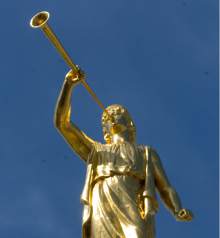This is an archived article that was published on sltrib.com in 2016, and information in the article may be outdated. It is provided only for personal research purposes and may not be reprinted.
If you've heard of Mormonism's Three Nephites appearing out of nowhere to change a flat tire and then vanishing, you know the work of William A. (Bert) Wilson.
Do you know about missionary "Dear John" letters, young proselytizers faking their daily work records or test-driving a Ferrari against mission rules, or old bishops passing gas in church meetings? Those would be in Wilson's corpus, too.
Collecting these gems was the former professor's passion as the father of Mormon folklore.
Wilson died this week at age 82, leaving behind family, friends and a treasure trove of these tales — more than 5,000 at Brigham Young University on mission experiences alone.
He taught twice at the LDS Church-owned Provo school as well as Utah State University in Logan, where he served as that school's director of the folklore program until 1985.
Through the decades, stories were his great love and obsession.
"Laughter can mitigate the harshness of reality," Wilson told The Salt Lake Tribune in 1998. "People who don't laugh are the ones who crack up."
For Mormon missionaries, storytelling creates an "esprit de corps" while providing cautionary examples, he said. "Good missionaries do not do what characters in the stories do. Yet they delight in telling the stories."
One of the first tales he ever heard involved two missionaries who make out their weekly reports two weeks in advance. They ask their landlady to send one a week to mission headquarters and then the two elders take off for some unapproved adventure. Unfortunately, their scheme is discovered when the woman sends the second-week report first.
"The unauthorized-trip story was told to us by missionaries in Australia, France, New York and a dozen other places,'' said Wilson, who traced it beyond Mormonism to students at Harvard University.
Another kind of story is the dramatic narrative of divine or satanic intervention.
In one account, missionaries hear about a photograph taken of an elder swimming, against mission rules, that shows a dark figure hovering near the swimmer. Others tell of these young LDS volunteers either being killed or tormented for violating a variety of rules: experimenting with spiritualism, boating, dating, playing rock music, arguing with companions, leaving companions or not working hard enough.
"Missionaries attempt to show what punishments will befall the erring and what rewards await the obedient," Wilson said. "These stories are told and retold because of their evocative and symbolic power."
Don't forget those Nephite narratives in which three strangers described in Mormon scripture as having a kind of immortality show up unexpectedly as helpers in modern times.
Wilson collected about 1,500 of them, he told interviewer Andrew Jorgensen in 2004. "My wife has helped me with those and ... she comments on the fact that what you find in these stories that you don't very often find in other supernatural legends is that once the old men have left, the people they have visited have been left with a good and peaceful, serene, happy feeling."
And so it went for Wilson, collecting, compiling and analyzing these anecdotes throughout his long life.
"Telling stories helps," he told the interviewer. "Listening to them sympathetically might help even more."
Peggy Fletcher Stack



